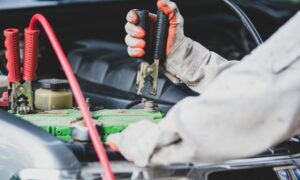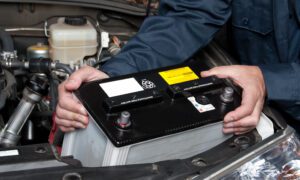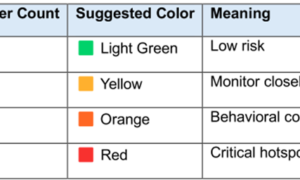Hey there, fellow car enthusiast! If you’re anything like me, you’ve probably experienced the frustration of a dead car battery at the worst possible moment. It’s that sinking feeling when you turn the key, and nothing happens. But fear not, because in this guide, we’re going to dive headfirst into the world of car battery chargers and uncover the secrets to keeping your ride running smoothly. So, grab a cup of your favorite beverage and let’s get started on this electrifying journey.
Choosing the Right Battery Charger for You
Before we dive into the technical details, let me share a quick anecdote with you. A while back, I found myself stranded in a desolate parking lot late at night. I had no choice but to call for help because my car battery had given up the ghost. That incident was a wake-up call, prompting me to explore the world of battery chargers.
When it comes to battery chargers, there are two main types to consider: standard battery chargers and trickle chargers. Let’s break them down for you.
Standard Battery Charger: The Quick Fix
Standard battery chargers, often referred to simply as “battery chargers,” are your go-to when you need a quick fix for a dead battery. These chargers deliver a burst of power to your battery, jumpstarting it back to life.
Picture this: You’re running late for an important meeting, and your car won’t start. A standard battery charger can be a lifesaver in such situations. With its potent jolt of energy, you can be on your way in no time.
Trickle Charger: The Slow and Steady Saver
On the other hand, trickle chargers are like the dependable friend who’s always there when you need them. These chargers provide a slow, steady stream of electricity to your battery, ensuring it remains charged over extended periods.
Now, let’s talk about the time I borrowed my neighbor’s trickle charger. He was always the kind of guy who was prepared for any situation, and I admired that. One day, I noticed he was working on his classic car in the garage and asked him about it. He told me that he used a trickle charger to keep his battery in tip-top shape, even during long periods of inactivity. Inspired by his wisdom, I decided to get one for myself.
The Benefits of Trickle Chargers
Trickle chargers offer several advantages that make them a valuable addition to your car maintenance toolkit. Here’s why you should consider getting one:
Longevity: Trickle chargers help prolong your battery’s life by preventing it from going completely flat during periods of inactivity. This can save you money on frequent battery replacements.
Convenience: Imagine never having to deal with a dead battery again. With a trickle charger, your car will always be ready to roll when you are.
Peace of Mind: Whether you’re going on a long vacation or simply have a vehicle you don’t use often, a trickle charger provides peace of mind, knowing your battery is in good shape.
Now, you might be wondering how to choose between a standard car battery charger and a trickle charger. Well, it depends on your needs. If you want a quick solution for jumpstarting a dead battery, a standard charger is your best bet. However, if you’re looking for a long-term solution to maintain your battery’s health, a trickle charger is the way to go.
IG – The Importance of Amperage
When shopping for a battery charger, you’ll come across a term called “amperage.” Amperage refers to the amount of current a charger can deliver to your battery. It’s a crucial factor to consider because it affects how quickly your battery will charge.
Imagine this scenario: You’re in a hurry to get to work, and your car’s battery is almost flat. You grab your standard battery charger, plug it in, and wait. The charger you picked up, however, has a low amperage rating, and it takes forever to get your car running. You can’t help but holla out in frustration.
This is where understanding amperage comes into play. A higher amperage charger will charge your battery faster, while a lower amperage charger will take more time. So, consider your needs and how quickly you want to get back on the road when choosing a charger.
Narcotics – Avoid Overcharging
Now, let’s touch on a critical point – overcharging. Overcharging your battery can be as harmful as not charging it at all. It’s like giving your car a dose of unnecessary narcotics, and it can lead to irreversible damage.
Some modern battery chargers come equipped with features to prevent overcharging, but it’s still essential to monitor the charging process. Make sure to follow the manufacturer’s instructions and check on your battery periodically during the charging process.
Understanding Voltage: Don’t Get Caught Off Guard
When it comes to car batteries, voltage is another essential aspect to understand. Most vehicles use a 12-volt electrical system. Therefore, it’s crucial to choose a charger that matches your battery’s voltage to avoid any mishaps.
Here’s an anecdote that underscores the importance of voltage matching. A friend of mine once borrowed a charger from someone without checking the voltage compatibility. As a result, they ended up damaging their car’s electrical system. It was an expensive mistake that could have been easily avoided.
So, before you connect that charger, double-check the voltage rating to ensure it matches your car’s battery. It’s a simple step that can save you from costly repairs.
Safety First – Proper Connection Matters
Now that you’ve chosen the right charger and ensured the correct voltage, it’s time to connect it to your battery. This step is crucial, and there’s no room for mistakes.
Let me share a quick story about a mishap with improper connections. A colleague of mine was in a rush to charge his battery before heading out for a weekend getaway. He didn’t pay close attention to the polarity and accidentally reversed the connections. The result? Sparks flew, and his battery was toast.
To avoid such a situation, always follow the manufacturer’s instructions for connecting the charger. Usually, it involves connecting the positive (red) clamp to the positive terminal and the negative (black) clamp to the negative terminal. Double-check the connections before plugging in the charger to ensure a safe and successful charging process.
In conclusion, when it comes to keeping your car’s battery in peak condition, the choice between a standard battery charger and a trickle charger depends on your needs. Standard chargers offer a quick fix for dead batteries, while trickle chargers provide long-term maintenance.
Remember, understanding amperage, avoiding overcharging, matching voltage, and making proper connections are all key to ensuring a successful charging process. With the right knowledge and equipment, you can say goodbye to the frustration of a dead battery and keep your car running smoothly.
So, the next time you find yourself in a bind or just want to maintain your battery’s health, don’t hesitate to power up with the right battery charger. Your car will thank you, and you
‘ll be ready for any adventure that comes your way. Happy driving!



































